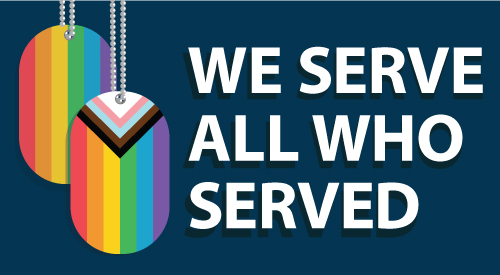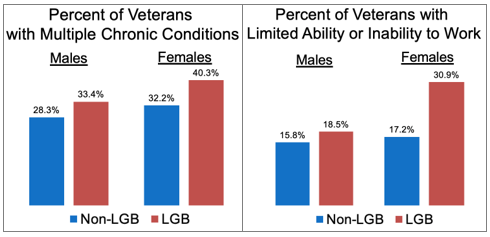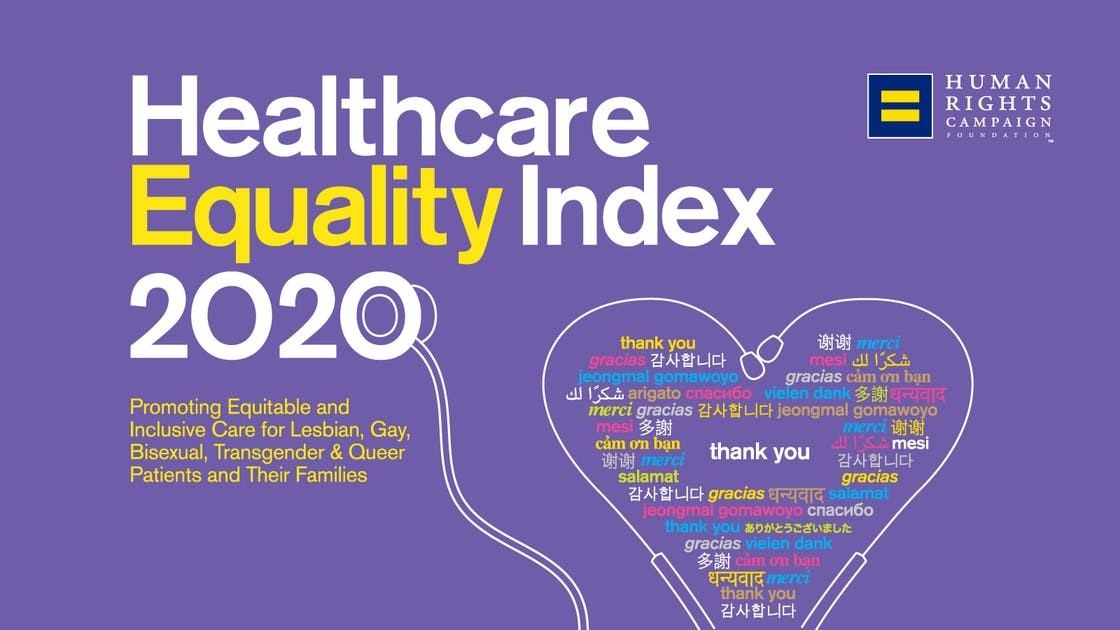Office of Health Equity
Health Disparities & Work Limitations Among Female LGB Veterans
Health Disparities & Work Limitations Among Female LGB VeteransJulia McGirr, MPH(c), MS, Office of Health Equity, Lauren Korshak, DHealth(c), MS, RCEP, Office of Health Equity |
 |
Download PDF
INTRODUCTION
The Veterans Health Administration (VHA) serves a Veteran population that is increasingly diverse. Equitable access to high-quality care for all Veterans is a major tenet of the VA healthcare mission. The Office of Health Equity (OHE) champions the elimination of health disparities and achieving health equity for all Veterans, including LGB Veterans.
In this infobrief, the term LGB refers to individuals that identified themselves as Lesbian, Gay, or Bisexual and the term non-LGB refers to individuals that identified themselves as “straight, that is not gay” in their responses to the National Health Interview Survey (NHIS).
HEALTH DISPARITIES
Female LGB Veterans are more likely to have multiple chronic health conditions than their non-LGB or male counterparts. These higher rates of chronic disease can be partially attributed to gender and orientation-based discrimination and sexual assault that female LGB Veterans may experience. Having multiple chronic conditions can also limit someone’s ability to be gainfully employed. According to data from the National Center for Health Statistics, female Veterans experience limitations in their ability to work more than male Veterans. Notably, almost one-third of female LGB Veterans face work limitations or are unable to work. This is a higher rate than their non-LGB counterparts.

SOURCE: NCHS, National Health Interview Survey, 2013-2018.
Tables available at https://www.cdc.gov/nchs/nhis/veterans_health_statistics/tables.htm
Not being able to work can lead to less financial stability, poor well-being, and development of depression. Therefore, it is a priority to ensure that all Veterans, but especially female LGB Veterans, get the support they need to be able to work to support a good quality of life for themselves and their family.
REDUCING DISPARITIES AND IMPROVING ACCESS
Barriers to receiving culturally competent healthcare can contribute to worse health outcomes for LGB individuals. A provider’s knowledge of a patient’s LGB status is essential to providing appropriate prevention screening and care.
Provider-focused education and inclusive facility policies are beginning to raise awareness about the unique needs and healthcare disparities facing LGB Veterans. There is growing support that these methods have contributed to improved LGB Veteran experience with VHA services.
HEALTHCARE EQUALITY INDEX
The Healthcare Equality Index (HEI) is a national benchmarking tool for promoting equitable and inclusive care for Lesbian, Gay, Bisexual, Transgender, and Queer (LGBTQ) patients and their families.
The HEI addresses healthcare disparities through the evaluation of the policies and practices of healthcare facilities. Facilities are evaluated on the criteria of cultural competency training, inclusive LGBTQ patient support, LGBTQ-inclusive employee policies, and engagement with the LGBTQ community.
Within the VA system in 2020, 64 VA medical centers were awarded Leader status and 34 as Top Performer. The HEI is a useful tool for marking the progress the VA continues to make in addressing healthcare disparities in the LGBTQ community. Providing equitable and inclusive care to LGBTQ Veterans will help to manage chronic conditions and the downstream work limitations faced by a disproportionate percent of LGB female Veterans in particular.

To find data on LGB and other groups of Veterans, visit: https://www.cdc.gov/nchs/nhis/veterans_health_statistics/veterans-health-info.htm
For more information about the Healthcare Equality Index visit: https://www.va.gov/healthequity/Healthcare_Equality_Index.asp and
https://www.hrc.org/resources/healthcare-equality-index
For more information about the Office of Health Equity visit: https://www.va.gov/healthequity/
References
Blosnich, J. R., Foynes, M. M., & Shipherd, J. C. (2013). Health Disparities Among Sexual Minority Women Veterans. Journal of Women’s Health, 22(7), 631–636. https://doi.org/10.1089/jwh.2012.4214
Kauth, M. R., et al. (2018). Lesbian, gay, and transgender veterans’ experiences in the veterans health administration: Positive signs and room for improvement. Psychological Services. Advance online publication. http://dx.doi.org/10.1037/ser0000232
Turner, J. B., & Turner, R. J. (2004). Physical Disability, Unemployment, and Mental Health. Rehabilitation Psychology, 49(3), 241–249. https://doi.org/10.1037/0090-5550.49.3.241



















